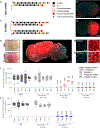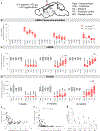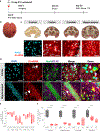A divalent siRNA chemical scaffold for potent and sustained modulation of gene expression throughout the central nervous system
- PMID: 31375812
- PMCID: PMC6879195
- DOI: 10.1038/s41587-019-0205-0
A divalent siRNA chemical scaffold for potent and sustained modulation of gene expression throughout the central nervous system
Abstract
Sustained silencing of gene expression throughout the brain using small interfering RNAs (siRNAs) has not been achieved. Here we describe an siRNA architecture, divalent siRNA (di-siRNA), that supports potent, sustained gene silencing in the central nervous system (CNS) of mice and nonhuman primates following a single injection into the cerebrospinal fluid. Di-siRNAs are composed of two fully chemically modified, phosphorothioate-containing siRNAs connected by a linker. In mice, di-siRNAs induced the potent silencing of huntingtin, the causative gene in Huntington's disease, reducing messenger RNA and protein throughout the brain. Silencing persisted for at least 6 months, with the degree of gene silencing correlating to levels of guide strand tissue accumulation. In cynomolgus macaques, a bolus injection of di-siRNA showed substantial distribution and robust silencing throughout the brain and spinal cord without detectable toxicity and with minimal off-target effects. This siRNA design may enable RNA interference-based gene silencing in the CNS for the treatment of neurological disorders.
Conflict of interest statement
COMPETING FINANCIAL INTEREST STATEMENT
AK, JFA, MRH and BMDCG have filed a patent application for branched-oligonucleotides.
Figures






References
-
- Ostergaard ME et al. Efficient Synthesis and Biological Evaluation of 5’-GalNAc Conjugated Antisense Oligonucleotides. Bioconjug Chem 26, 1451–1455 (2015). - PubMed
-
- Rajeev KG et al. Hepatocyte-specific delivery of siRNAs conjugated to novel non-nucleosidic trivalent N-acetylgalactosamine elicits robust gene silencing in vivo. Chembiochem : a European journal of chemical biology 16, 903–908 (2015). - PubMed
-
- Finkel RS et al. Nusinersen versus Sham Control in Infantile-Onset Spinal Muscular Atrophy. N Engl J Med 377, 1723–1732 (2017). - PubMed
Publication types
MeSH terms
Substances
Grants and funding
LinkOut - more resources
Full Text Sources
Other Literature Sources
Molecular Biology Databases

